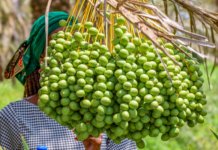Without pest control products, it would be impossible to produce enough potatoes to meet consumer demand. Traditionally, potato producers follow a strict, preventative spray programme to protect their crops. This approach is important, especially to ensure effective disease management. However, with insects such as potato tuber moth, a more calculated approach is possible. Although several registered options exist for the effective control of potato tuber moth, cracks are starting to appear in the armour of some of the available active ingredients. If the correct strategy and products are not used, potato tuber moth can destroy an entire potato crop.
Against the backdrop of ever-increasing production costs, producers simply cannot afford for a significant percentage of a crop to be rejected or even downgraded due to insect damage. Literally millions of rands are at stake.
With this in mind, InteliGro and Stef Stephan from Stephan & Seun Potatoes joined forces to launch a long-term potato-monitoring project in 2016. Under the leadership of André Erasmus, InteliGro’s potato technical specialist, the project has since gained tremendous momentum and is currently an integral part of the service and decision-making support InteliGro offers in the Sandveld potato-production region.
“Monitoring is already an established practice in the deciduous fruit and citrus industries,” explains Erasmus. “It can, however, also be used successfully on other crops, such as potatoes, given that it lays the foundation for effective decision making and sustainable solutions.”
Monitoring is a partnership between nature and agriculture. The pheromones that female moths secrete to attract males for mating, are synthesised in laboratories and packaged in ampules. The ampules are placed in traps and, as they attempt to get to the sources of the pheromones, male moths are caught in the traps. A trained monitor counts the moths once a week and the information is used to plot trends and take informed decisions by answering questions such as:
- Is the pest present or not?
- Are numbers at a level where action needs to be taken, or not?
- Are current measures successful, or should application intervals, dosages and/or products be adjusted?
South Africa has approximately 60 000 hectares under potato production. The monitoring project has proven itself over and over again in the irrigation fields of the Sandveld, and is now ready to support potato farmers in other parts of the country.
“Stephan & Seun Potatoes bought into the InteliGro monitoring project from the start,” says Stephan. “Over the past four years, the value of actual measuring has given us more confidence and our weekly preventive spray programmes have started to make room for spray programmes that are 100% based on the weekly monitoring results. We now use less chemicals than before to control potato tuber moth, because monitoring has taught us to spray at the right time and only when the insect pressure is high. This InteliGro initiative is a massive success story and a step in the right direction.”
“We have, over four seasons in the Sandveld, experienced the value that monitoring can add to yield and quality,” says Erasmus. “We know the extent to which it helps to refine producers’ risk management and reduce their input costs due to the decreased use of crop protection products. The time has come to share the benefits of integrated pest management with producers in other potato-production regions of the country.”
According to Potatoes SA, an average of 6% of potatoes that reach South Africa’s fresh-produce markets are downgraded; this is in addition to the tonnes that are culled in pack stores on farms. Monitoring and more effective strategies can significantly improve this situation. “When producers take the right steps at the right time and for the right reasons, they save money and improve their chances for a successful harvest. In addition, we all work together to protect the pest control products currently available to us,” notes Erasmus.
In collaboration with Cropwatch Africa, InteliGro presents a technology platform that allows the weekly monitoring data to be captured and shared electronically with producers. The platform also creates the opportunity for a wider variety of information, such as satellite images, weather data and application details, to be gathered. Referencing this information will in future enable producers to fine-tune decision making and record keeping on the farm.
InteliGro invests in research, trials and technical expertise to make monitoring on the farm easier. “We know that food security starts on the farm and is built on effective decision making that protects crops and ensures optimal yields,” concludes Erasmus.







